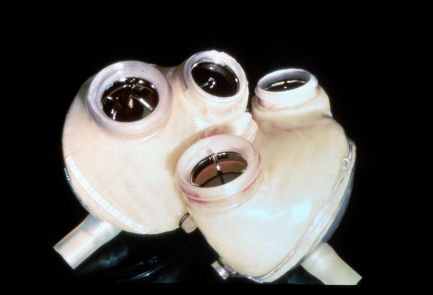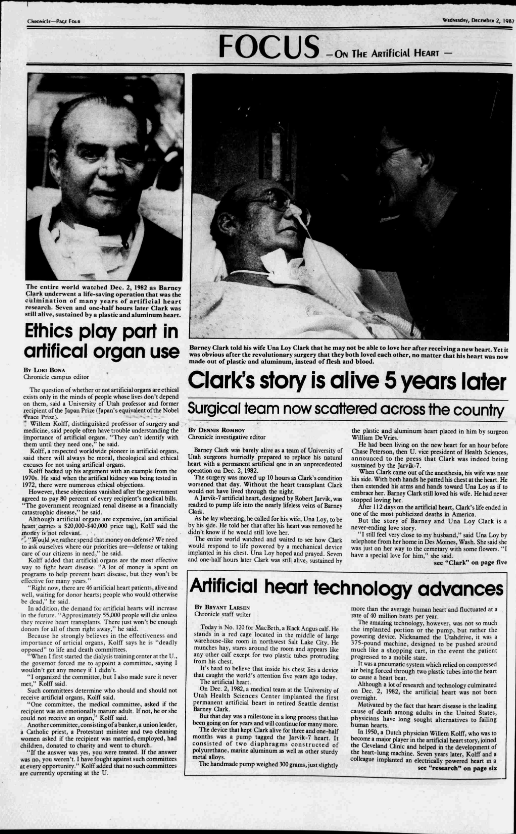In December 1982, doctors at the University of Utah grabbed the world’s attention by putting an artificial heart in one brave patient, Barney Clark. An artificial heart is a kind of machine designed to do the heart’s work by pumping blood.
In Short
People across the globe watched in amazement. Some thought it was too much like Frankenstein. Clark only lived for 112 days after the surgery, but his courage helped many other people.
Years of Practice

When the organs in a person’s body become sick, their entire body suffers. Today, it is possible to transplant an organ—such as a liver or even a heart—from one person to another. But it wasn’t always possible. For most of history, people with heart problems died and doctors could do little to help them. Scientists tried to solve this problem by creating devices that copied the way the human heart works.
Willem Kolff began inventing machines that he hoped would help people in the 1940s, in Europe. He came to work at the University of Utah in 1967. Kolff invented several different artificial organs. He hoped these devices could replace sick kidneys, lungs, hearts, and eyes.
Kolff and other talented doctors worked together at the Institute for Biomedical Engineering at the University of Utah. In the 1970s, they practiced putting artificial hearts in animals to make sure the devices would be safe for humans. At the same time, researchers in other places were also inventing machines to help people with sick hearts.
The Patient and the Device
The scientists at the University of Utah Medical Center, led by Kolff, looked for a patient who could use their artificial heart. They named it the Jarvik-7 after Robert Jarvik, its inventor and a member of the team. This device was the first of its kind. It was made of polyester, plastic, and aluminum, and it was connected by hoses to a 400-pound air compressor.
The Patient was Dr. Barney Clark
Clark was a dentist from Seattle, Washington, whose heart was failing. He could hardly walk from one room to another, and he felt very weak and ill. But Clark was also a brave man who wanted his experience to help others. He agreed to become the first person to have a “total artificial heart” permanently placed in his body.
On December 1, 1982, a team of doctors performed a seven-hour surgery on Clark. They removed his sick heart and replaced it with the Jarvik-7. Clark had to be attached to a giant air compressor that powered the artificial heart for the rest of his life.

Was it Ethical?
Clark knew that he had little chance of living after the surgery, but he agreed to help science and other people. He lived much longer than anyone expected, but he was miserable. He had infections, strokes, seizures, and depressing thoughts.
Some people wondered if the artificial heart operation was ethical or what medical professionals should do. They wanted to make sure patients’ bodies and rights were protected. Plus, an artificial heart costs a lot of money. Clark and his doctors thought it was ethical. What do you think?
After the Operation
News reporters worldwide told the story of Barney Clark and the artificial heart operation in Utah. People saw Clark and his wife, Una Loy, as heroes. Clark could never leave the hospital, but he did get to celebrate his wedding anniversary with Una and their children.
Clark died 112 days after his surgery. The Jarvik-7 beat almost 13 million times in his body, and it kept working after he died. Clark’s courage inspired doctors to wonder what could be possible and what other kinds of devices could help people with sick hearts. Just as he hoped, his experience meant other people might have better lives.
Keep Exploring!